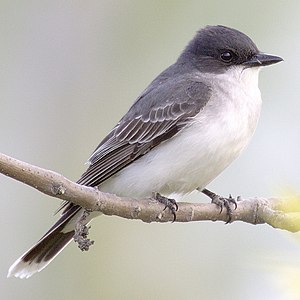I also saw a new bird today that I don’t know the name of. It’s very pretty, black with a white belly. Can you please take a look and let me know what kind it is?
Thanks, and hope you’re having a great spring! -Angie in Monroe, NC
Hey, I'm so glad you wrote. A lot of people keep birding journals to help them remember what happens when. It seems funny but I like to look back to see what's coming.
The Merganser family looks like their doing well. Great family photo!
 Image via Wikipedia
Image via WikipediaAt the first signs of spring, they migrate from their wintering grounds in the southern states, Cuba and Guatemala to their breeding grounds from the middle and northern states in America to much of Canada.
They prefer open areas in the sun, pastures, fields and golf courses and nest in natural tree cavities, or man-made nest boxes, including those built for bluebirds. The bluebird and swallow are both native species and both desirable birds to have in your yard. One proven technique that allows both songbirds to nest together successfully is to set up pairs of boxes, no more than 10-20 feet apart. Since Tree Swallows will not allow another pair of swallows to nest within 20', the second box is free for bluebird use and the two species can co-exist, after some initial squabbling to sort out who gets which box.
Swallows make their nests from grass and weed stems and line them with feathers. They usually have 3-7 eggs. Their eggs are white and unmarked. Young usually fledge in 16 to 24 days
Tree swallows can often be seen perching in long rows on wires. They also spend much of their time in flight. To bathe, swallows swoop down over a body of water and lightly brush the water. To eat, swallows catch mostly winged insects while in flight, but can forage on the ground for insects, spiders, seeds, and berries.
More information can be found at: http://www.allaboutbirds.org/guide/Tree_Swallow/id
Thanks for writing again. Sarah
Update:
 Image via Wikipedia
Image via WikipediaMore about the bird can be found at: http://www.allaboutbirds.org/guide/Eastern_Kingbird/id
They’re a country bird like the Tree Swallows and are insect eaters too. They don’t nest in a cavity however. They build a cup-shaped nest on a flat limb or tree stump.
The kingbird lives up to its scientific name Tyrannus tyrannus or tyrant by defending its territory aggressively, even against much larger birds. It can also spot cowbirds’ eggs and toss them out of their nest.
Thank you David for reading the post and helping out with our mystery bird!
Category ›
Bird of the week
 Unknown
Unknown
 Wednesday, April 27, 2011
Wednesday, April 27, 2011












No comments:
Post a Comment